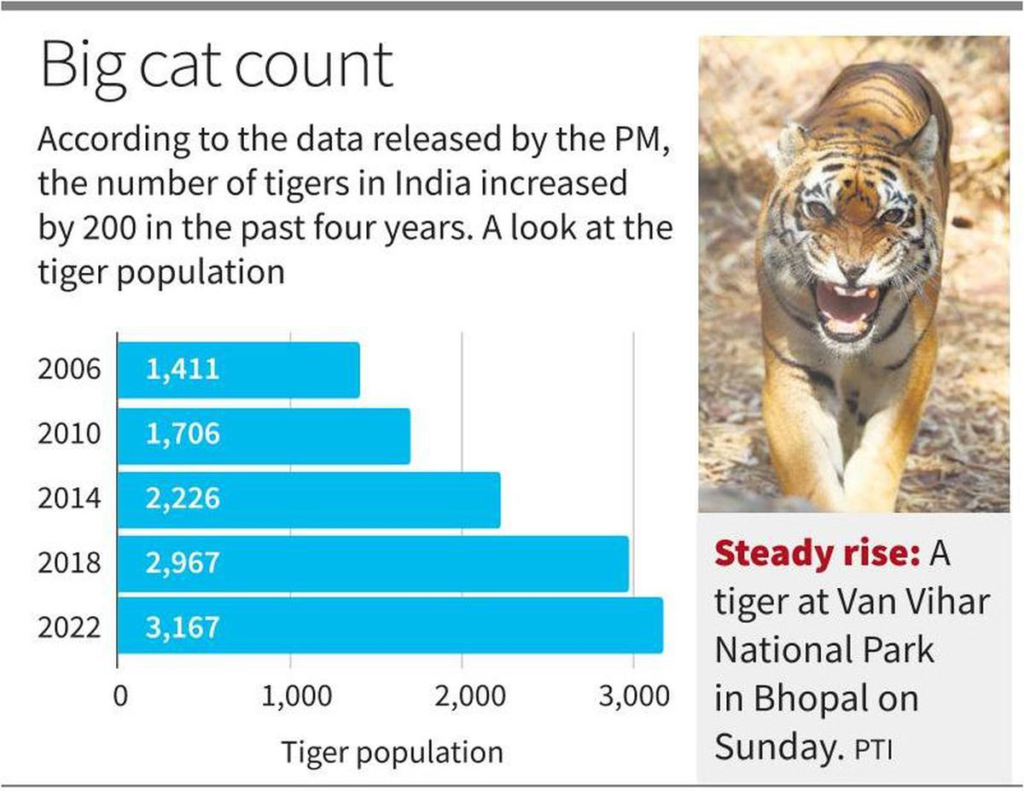The Tiger Census 2022 has unveiled a captivating success story that resounds with hope and determination. In this groundbreaking census, Madhya Pradesh emerges as a true leader in tiger conservation, with an astounding count of 785 tigers. This achievement is nothing short of remarkable, signaling a triumph for both wildlife enthusiasts and conservationists alike. Madhya Pradesh’s commitment to preserving these majestic creatures and their habitats shines brightly in the face of numerous challenges that tigers encounter across the globe.
The heart of this success lies in Madhya Pradesh’s unwavering dedication to wildlife preservation. Rigorous anti-poaching efforts, the expansion of protected areas, and active community involvement have all played pivotal roles in securing this impressive tiger population. These initiatives not only ensure the safety of these apex predators but also contribute significantly to maintaining the ecological balance of the region.
Moreover, the success in Madhya Pradesh serves as an inspiring example for other states and countries grappling with dwindling tiger populations. It showcases the tangible results of diligent conservation strategies and reinforces the idea that with concerted efforts and collaboration, we can reverse the decline of these iconic species.
The Tiger Census 2022: MP Takes the Lead with 785 Tigers is more than just a statistical milestone; it represents a beacon of hope for the future of tigers in India and worldwide. It underscores the importance of continued vigilance, support for conservation initiatives, and a shared commitment to coexisting with the wild. Madhya Pradesh’s roaring success story reminds us that with collective determination, we can ensure a brighter, safer future for tigers and the diverse ecosystems they inhabit.
Table of Contents
Introduction to Tiger Census 2022
The Tiger Census 2022 represents a pivotal moment in the ongoing saga of wildlife conservation in India. This comprehensive assessment offers a profound glimpse into the current status of our planet’s most magnificent big cats, the tigers. Beyond being mere numbers, these census results signify a collective effort to safeguard a species on the brink of extinction. The data not only quantifies their existence but also serves as a beacon, guiding us toward a more profound understanding of the challenges they face.
As we dive into this blog post, we embark on a journey that traverses the length and breadth of India, from the heartland of Madhya Pradesh, where tigers reign supreme with a remarkable count of 785, to the picturesque landscapes of the UK’s Corbett Tiger Reserve, which boasts a record-breaking 260 tigers. However, our journey is not without its shadows, for we must also confront the harsh reality of Mizoram’s Dampa Tiger Reserve, where the count stands at a concerning zero once again.
The Tiger Census 2022 is more than just numbers; it’s a call to action, an opportunity to delve into the intricate web of conservation efforts, and a testament to the enduring spirit of those dedicated to preserving these iconic creatures. In the pages that follow, we will explore the triumphs, the challenges, and the urgent need for wildlife conservation as we stand on the precipice of change for the future of tigers in our world.

Tiger Population Statistics
The Tiger Population Statistics reveal a complex and, at times, distressing picture of the current state of these iconic big cats. The 2022 census data serves as a crucial barometer for assessing the health and sustainability of tiger populations across various regions. On one hand, the impressive 785 tigers in Madhya Pradesh underscore the effectiveness of conservation efforts in certain areas, offering hope for the species’ survival.
Corbett Tiger Reserve’s achievement of recording 260 tigers in the UK is another ray of light, showcasing the positive impact of dedicated conservation initiatives. However, the stark reality of zero tigers in Mizoram’s Dampa Tiger Reserve is a stark reminder of the challenges that tigers still face. This sobering statistic highlights the urgent need for comprehensive conservation strategies in regions where tigers are struggling to survive.
It’s a call to action for governments, conservation organizations, and individuals worldwide to unite in their efforts to protect these majestic creatures. The tiger population statistics not only provide valuable data but also serve as a poignant reminder of our responsibility to ensure a future where tigers continue to roam the wild, contributing to the rich tapestry of our natural world.
Madhya Pradesh’s Remarkable Lead with 785 Tigers
Madhya Pradesh’s remarkable lead with 785 tigers in the Tiger Census 2022 is a testament to the state’s unwavering commitment to wildlife conservation. It reflects not only the state’s rich biodiversity but also its dedication to preserving these majestic creatures and their habitats.
This achievement is not merely a statistic but a symbol of the tireless efforts put forth by conservationists, forest officials, and local communities in safeguarding the tiger population. Madhya Pradesh’s success story highlights the importance of strategic conservation initiatives, such as strengthening anti-poaching measures, expanding protected areas, and actively involving communities in conservation projects.
In this remarkable endeavor, the state has set an example for others to follow in the quest to protect endangered species and ensure their coexistence with humans. The 785 tigers in Madhya Pradesh represent hope for the future, as these magnificent creatures continue to play a vital role in maintaining ecological balance.
It is a call to action for other regions and countries to replicate these efforts, recognizing that the conservation of apex predators like tigers has a cascading effect on preserving entire ecosystems. Madhya Pradesh’s lead in the Tiger Census 2022 is not just a number; it’s a beacon of hope, urging us all to do our part in securing a future where tigers thrive in the wild.
Corbett Tiger Reserve: UK’s Conservation Triumph with 260 Tigers
Corbett Tiger Reserve, nestled in the heart of the United Kingdom, stands as a beacon of hope and a testament to the power of conservation efforts. In the recently concluded Tiger Census of 2022, this reserve recorded an astounding 260 tigers, reaffirming its status as a global leader in wildlife preservation. The achievement is not merely a statistic but a symbol of unwavering dedication to safeguarding one of the planet’s most iconic and endangered species.
The success of Corbett Tiger Reserve can be attributed to a combination of factors, beginning with a robust conservation strategy that encompasses habitat restoration, strict anti-poaching measures, and continuous research into tiger behavior and ecology. These efforts have ensured that tigers have a secure and thriving environment in which they can breed and flourish.
Furthermore, Corbett Tiger Reserve serves as a model for community engagement in conservation. Local communities have been actively involved in initiatives that promote coexistence with wildlife, raising awareness about the importance of these majestic creatures in the ecosystem. This collaborative approach not only protects tigers but also benefits the livelihoods of those who live in close proximity to the reserve.
The success of Corbett Tiger Reserve also highlights the broader significance of tiger conservation. Tigers are not just charismatic megafauna; they are keystone species that play a pivotal role in maintaining the balance of their ecosystems. Protecting tigers means safeguarding the biodiversity and ecological health of entire landscapes.
In a world grappling with habitat loss, poaching, and climate change, Corbett Tiger Reserve’s achievement offers a glimmer of hope. It demonstrates that with unwavering commitment, international cooperation, and a deep respect for the natural world, we can reverse the tide of species decline. Corbett’s 260 tigers stand as a reminder that when humans and nature work hand in hand, remarkable conservation triumphs are possible, giving us hope for the future of not only tigers but also our shared planet.
Mizoram’s Dampa Tiger Reserve: A Concerning Zero
Mizoram’s Dampa Tiger Reserve’s recurring report of zero tigers in the 2022 census is a distressing revelation that demands our immediate attention. This concerning trend not only signifies the fragile state of tiger populations in this region but also raises critical questions about the effectiveness of conservation efforts. It underscores the urgent need for comprehensive measures to reverse this decline and revive the tiger populations in Dampa.
The zero count is a stark reminder that tigers in this reserve are facing unprecedented challenges. These challenges may include habitat degradation, illegal poaching, human-wildlife conflicts, and a lack of resources for effective conservation. To address this crisis, it is imperative to conduct a thorough assessment of the reserve’s habitat, identifying and rectifying any factors that hinder tiger populations from thriving. This could involve habitat restoration projects, protection of critical wildlife corridors, and the establishment of stringent anti-poaching measures.
Collaboration with local communities is another key aspect of revitalizing tiger populations in Mizoram. Engaging with the people living in and around the reserve is crucial for raising awareness about tiger conservation and garnering their support for protective measures. Local communities can play a pivotal role in reporting illegal activities, assisting in habitat restoration, and participating in conservation programs.
Furthermore, it is essential for governmental and non-governmental organizations to pool resources and expertise to address the crisis in Dampa. Funding for conservation initiatives, research on tiger behavior and ecology, and public awareness campaigns should be prioritized to ensure the sustainable recovery of this region’s tiger population.
In conclusion, the zero tiger count in Mizoram’s Dampa Tiger Reserve serves as a somber reminder of the precarious state of tigers in certain regions of the world. However, it also represents an opportunity for us to take proactive steps, implement robust conservation strategies, and work together to ensure that tigers once again roam freely in this biodiverse habitat. It’s a challenge we must meet head-on to protect the magnificent species and preserve the delicate balance of our ecosystems.
The Significance of Wildlife Conservation
The significance of wildlife conservation extends far beyond the preservation of individual species; it encompasses the very essence of our planet’s health and equilibrium. Tigers, as apex predators, play a pivotal role in maintaining the delicate balance of ecosystems. Their presence indicates the vitality of an entire habitat, reflecting the health of prey populations and the overall biodiversity. When we conserve tigers, we are, in fact, conserving the entire web of life that depends on them. Furthermore, the benefits of wildlife conservation extend to humans as well.
It ensures the protection of valuable genetic resources for future research and potential medical discoveries. Conservation also contributes to the tourism industry, creating economic opportunities for local communities. Moreover, the ethical dimension of safeguarding these magnificent creatures cannot be overstated.
It reflects our responsibility as stewards of the natural world, emphasizing our duty to ensure that future generations can marvel at these majestic animals in the wild. In essence, wildlife conservation isn’t just an option; it’s an imperative for the health of our planet, the survival of countless species, and the legacy we leave for our descendants.
Understanding the Tiger Census Methodology
Understanding the Tiger Census Methodology is crucial for gaining insights into the intricate process of assessing tiger populations and ensuring the accuracy of the data collected. The methodology employed in such censuses involves a combination of advanced techniques and on-ground efforts. One key aspect is camera trapping, where motion-activated cameras are strategically placed in tiger habitats to capture images of the elusive cats. These images are then meticulously analyzed to identify individual tigers based on their unique stripe patterns.
Additionally, researchers collect data on tiger tracks, scat, and vocalizations, all of which contribute to a comprehensive understanding of tiger presence and behavior. DNA analysis is often used to confirm the identity of tigers and ensure that there are no duplications in the count. Moreover, the census also takes into account the estimation of prey density, as the availability of prey is directly linked to tiger populations.
Understanding the methodology not only highlights the scientific rigor involved but also emphasizes the need for sustained funding, skilled personnel, and technological advancements in wildlife conservation. By supporting these efforts and promoting transparency in data collection, we can contribute to the preservation of these iconic and endangered species, ultimately ensuring a harmonious coexistence between tigers and their natural habitats.
Challenges and Threats to Tiger Populations
Tiger populations across the world face a myriad of challenges and threats that put their existence in jeopardy. One of the most significant threats is habitat loss due to deforestation, urbanization, and agricultural expansion. As pristine forests shrink, tigers lose their natural hunting grounds, leading to increased human-wildlife conflicts as they encroach on human settlements in search of food. Poaching is another grave concern, driven by the illegal demand for tiger parts in traditional medicine and the black market. The relentless pursuit of tiger skins, bones, and other body parts threatens to decimate their numbers.
Moreover, climate change is altering tiger habitats, affecting prey species’ distribution and availability. This disruption in the ecological balance further compounds the challenges faced by these magnificent predators. Human activities, such as mining, infrastructure development, and road construction, fragment tiger habitats, making it difficult for them to find mates and maintain genetic diversity within their populations. This fragmentation can lead to inbreeding and reduced reproductive success.
Conservationists and governments must work tirelessly to mitigate these threats. This involves enforcing stricter anti-poaching measures, preserving and restoring tiger habitats, and promoting sustainable development practices that balance human needs with wildlife conservation. Additionally, raising awareness about the importance of tigers in maintaining healthy ecosystems is crucial to garner public support for their protection. By addressing these challenges head-on and implementing sustainable solutions, we can hope to secure a future where tigers continue to roam our planet’s wild landscapes.
Conclusion: Taking Action for Tiger Preservation
In conclusion, the Tiger Census 2022 serves as a poignant reminder of the urgent need for action in the realm of tiger preservation. These majestic creatures, symbols of strength and grace, are not just icons of the wild; they are vital components of our planet’s delicate ecological balance. The census results, with Madhya Pradesh leading the way, Corbett Tiger Reserve’s success, and Mizoram’s alarming zero count, highlight the stark contrast in the conservation efforts and challenges faced across different regions. It is imperative that we collectively take responsibility for the protection of tigers and their habitats.
To truly make a difference, we must engage on multiple fronts. Joining local conservation groups allows us to actively contribute to preserving these incredible animals. It is through our participation in awareness campaigns that we can rally others to this noble cause, spreading the message that the fate of tigers is intertwined with the health of our ecosystems. Additionally, we can play a pivotal role in urging governments and policymakers to prioritize tiger conservation by voicing our concerns and supporting legislation aimed at protecting these endangered species.
By taking these steps, we not only ensure the survival of tigers but also safeguard the natural heritage of our planet for future generations. The Tiger Census 2022 is not just a report; it’s a call to action, a plea to recognize that our actions today will determine whether these magnificent creatures continue to roam our forests or fade into the annals of history. Together, we can make a difference, ensuring that the roar of the tiger continues to echo through the wild landscapes, reminding us of the irreplaceable beauty and importance of our natural world.




